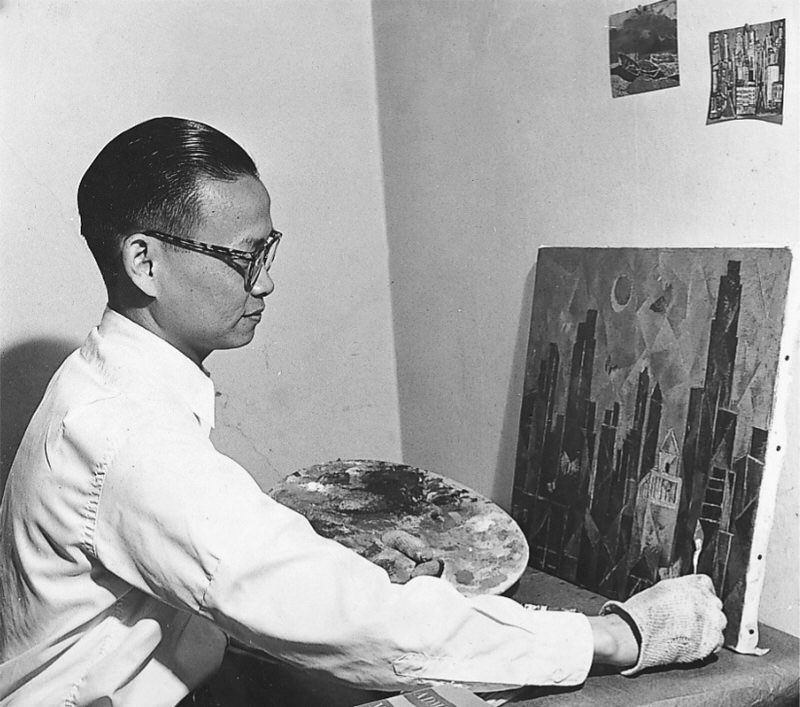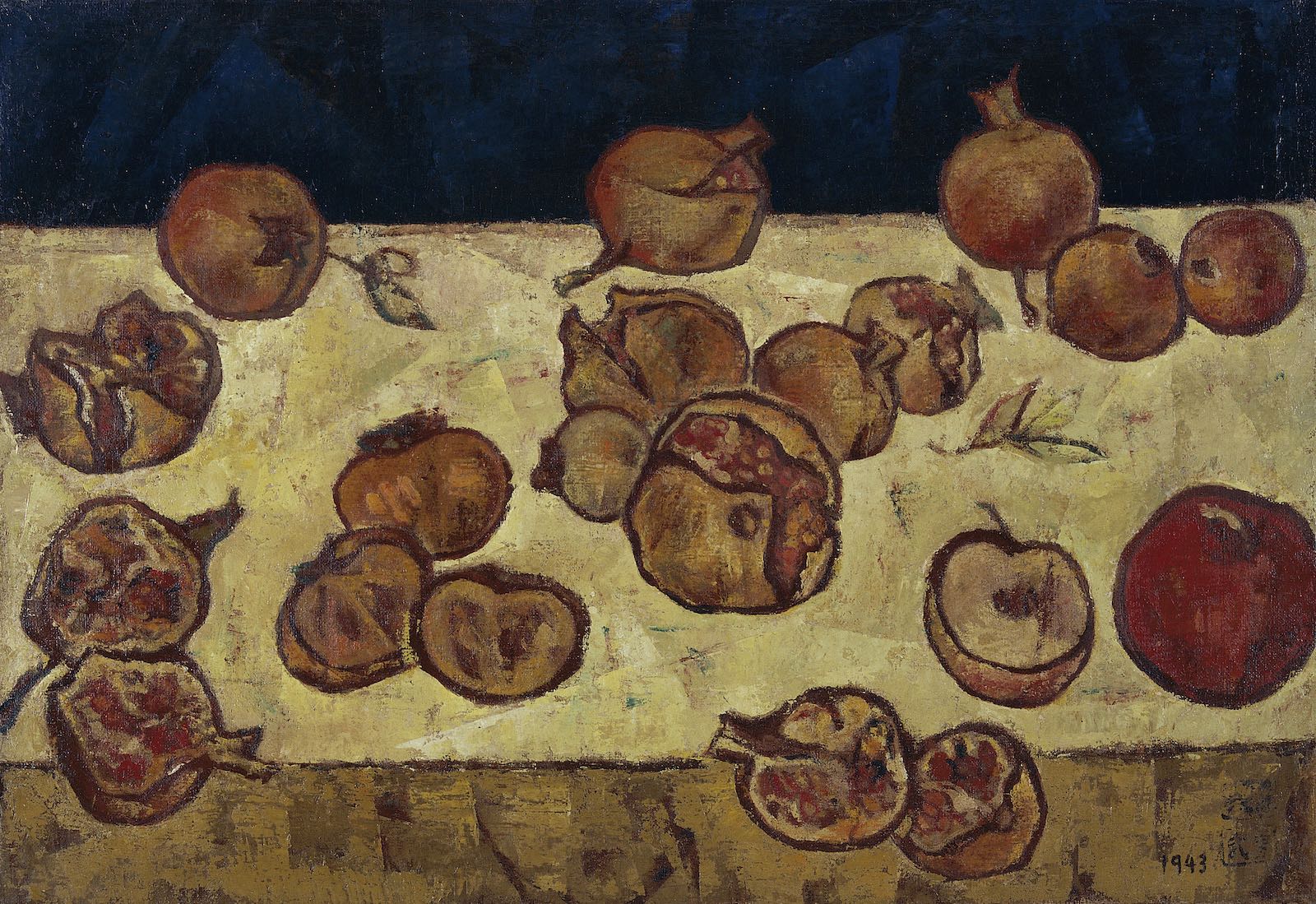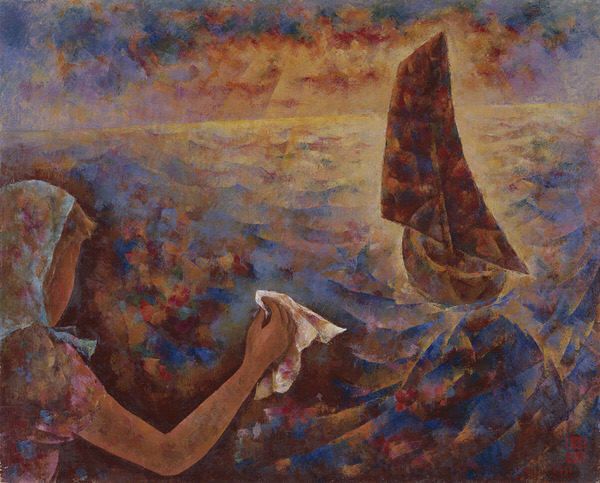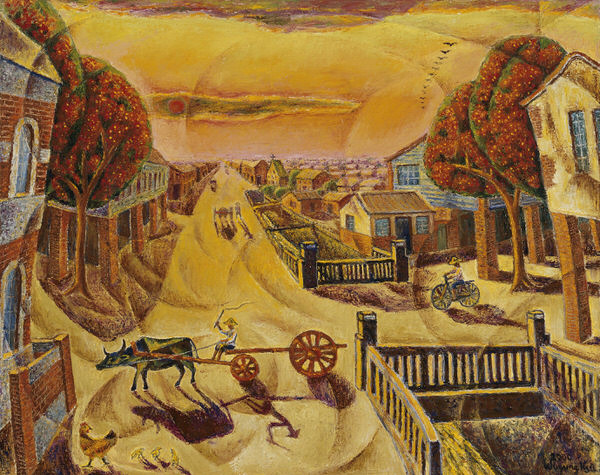Artist
A brief introduction to Wu‑Yung Hsu
畫家介紹
認識許武勇


Wu-Yung Hsu was born in Tainan City in 1920. He grew up during the Japanese occupation of Taiwan, and received a Japanese education. During his time at Taipei High School, he was taught by art teacher Shiotsuki Tōho (鹽月桃甫), who greatly influenced his desire to pursue arts. In 1941, he graduated with honors and was admitted into Tokyo Imperial University, School of Medicine.
In order to continue his art education, he joined Tsuishumai (踏朱會), the art society of the School of Medicine, and was mentored by Higuchi Karoku (樋口加六), a member of the Dokuritsu Fine Arts Society (独立美術協会). While at Higuchi's studio, Hsu practiced charcoal sketches, mostly of nude portraits, laying a solid foundation for painting.
許武勇,1920年出生於台南,在日本教育的薰陶下長大。在就讀台北高等學校期間,受美術老師鹽月桃甫指導,影響甚深。1941年以第一名的成績畢業,並考上東京帝大醫科。
為了更精進於美術,許武勇加入東大醫學部的美術社團「踏朱會」,由日本獨立美術協會會員樋口加六擔任指導。東京帝大的這四年,許武勇在樋口的畫室練習炭筆素描,內容全為裸體的人像,奠定了紮實的繪畫基礎。

In 1943 while in medical school, Wu-Yung Hsu participated in his first exhibition. The Crossroad symbolized the artist at a crossroad, wondering where to go to next in life. It was selected for the 13th Independent Art Association (Dokuritsu) Exhibition held at The Ueno Royal Museum in Tokyo. At the time, Hsu's art teacher told him that he would be better suited as an artist than a doctor.
Encouraged by this experience, at age 24, Wu-Yung Hsu was determined to continue his pursuit in art. In 1944, he graduated from medical school and continued his medical residency.
In 1945, WWII ended and Taiwan was transferred to the control of Republic of China government. In 1946, Wu-Yung Hsu returned to Taiwan and married Shu-Hsiang Hsu. The young couple first settled in Alishan of Chiayi County where Hsu practiced medicine. Later, the couple relocated to Kaohsiung and Tainan.
〈十字路〉是許武勇自1943年尚在東京帝大就讀時,第一次的參展作品。畫家筆下的台灣,如同擺盪在十字路口般,不知如何是好。作品入選第十三屆獨立美術展,並在日本上野美術館公開展出。當時,美術老師樋口加六對他說:「你當畫家會比當醫生更適合。」
老師的鼓勵加上初試啼聲即獲日本獨立美術協會入選,令當時年僅24歲的許武勇更堅定了走藝術之路的決心。1944年,他從東京帝大醫科畢業,取得醫學博士學位。
1945年,大戰結束,臺灣光復後交給國民政府。1946年,許武勇回到故鄉台灣,與徐淑香小姐結婚。由於知道阿里山林場剛好欠缺一位醫師,許武勇帶著新婚不久的妻子前往擔任林場醫師。後來回到台南和高雄行醫。

In 1947, the February 28 Incident occurred, Wu-Yung Hsu's friends and relatives were among those who were killed. One day while running errands, Hsu witnessed a public execution held at the Chiayi Railway Station. The subsequent White Terror period followed, the Taiwanese intellectuals of the time were prosecuted and silenced.
In 1952, Hsu passed the exam to obtain a US public scholarship to study in the United States. He studied Public Health at UC Berkeley. Using his time abroad, he traveled throughout America to visit different art museums, getting to know Western art.
In 1953, Wu-Yung Hsu held his first solo exhibition at Lucien Labaudt Art Gallery in San Francisco, becoming the first Taiwanese painter to held an exhibition in the US. Upon returning in to Taiwan, his artworks were shown at the annual Taiwan Provincial Fine Arts Exhibition, where A Rural Village (2) won the highest honor at the 10th Provincial Exhibition. In the subsequent decade, Hsu presented Cubism paintings at each annual exhibition, cementing his place as a pioneer of Cubism in Taiwan.
1947年,二二八事件發生,許武勇認識的親朋好友遭到殺害。在一次下山採買日用品的過程中,於嘉義火車站親眼目睹被槍斃的屍體。隨後的白色恐怖,又陸續有親友遭到不測。知識份子一夕間全都噤若寒蟬。
1952年,許武勇經考試取得美國公費獎學金赴美留學。當時在柏克萊大學研究公共衛生,藉由留學的機會,足跡踏遍美國東西兩岸美術館及當地的展覽,接觸西方藝術的寶庫。
1953年,許武勇在美國舊金山 Lucien Labaudt 畫廊舉辦油畫個展,這是畫家的第一次個展,也是台灣畫家第一次在美國的個展。返國後,許武勇隨即以〈農村(2)〉在第十屆的省展拿到第三次的特選,並因此獲得大會最高榮譽獎 。往後省展的展覽場,許氏連續十餘年間展出立體主義畫作,是臺灣美術界裡立體派的先驅。

Returning to Taiwan at the completion of his studies, Wu-Yung Hsu continued to work at the Lujhu Township Health Center in Kaohsiung. However, in order to participate in more of Taiwan's art scene happenings, Hsu decided to relocate to Taipei City and settle down. At 46, he opened Wu-Yung Clinic in Taipei, where he continued his day job as a medical doctor on the 1st floor clinic, while continue to paint in his art studio on the 2nd floor. Hsu never gave up his dream of being a full-time artist. He used his income from practicing medicine to maintained his creative pursuit and taking care of his family.
During this period, Wu-Yung Hsu also began to express in his own style of painting—the "Romanticism" (羅曼主義). In 1987, Hsu was diagnosed with colon cancer. Upon making a full recovery after the surgery, he had the realization that life was fleeting and that he had limited time remaining to pursue his own ideals. Hsu decided to retire from the medical profession and become a full-time painter.
得到美國碩士學位後返台,許武勇繼續在高雄縣路竹鄉衛生所行醫。然而,他為了能夠就近參與美術活動,46歲那年來到台北定居,開設「武勇診所」,一樓當診所,二樓則作為他的個人畫室。許武勇一輩子都沒忘記當一位專業畫家的夢想,他用醫生看病的收入維持創作生涯。
在這段時期中,許畫家也開始表現出他自己所創作出的風格-所謂的『羅曼主義』畫風。1987年許武勇發現自己罹患了大腸癌。開刀治療之後,許式驚覺人生稍縱即逝,認為在剩餘有限的生命裡應該追求自己的理想。抗癌成功後,決定自醫界退休,成為專職的畫家身份。

As a doctor who had witnessed life's suffering and illness on a regular basis, Wu-Yung Hsu often said, "the life of one's body always comes to an end in an instant, only art is eternal". He believed art was the only medium to pass on one's ideal and thoughts, forever.
After retiring from practicing medicine, Hsu cherished every moment of his life to devote himself to his creative pursuit as an artist. His artworks preserved and recognized his love to this world, to this life, and to Taiwan. Wu-Yung Hsu published his final art album in 2013, which represented as a summary of his life's work. In 2016, he fell ill and passed away in Taipei City at the age of 96.
作為醫生常見生命中的生老病衰,這樣的人生經驗讓許武勇常說:「有身體之生命總在一瞬間就走到盡頭,只有藝術才是永遠的生命」,他相信只有藉由藝術才能將美的思想與生命永久流傳下去。
退休後的許畫家,更珍惜活著的每一分、每一秒,全心投入創作。他的創作保存著對世界、對生命、對台灣這塊土地的熱愛與認同。許武勇於2013年出版了最後一本畫冊,同時也算作是他一生畫圖的總結 。 2016年,年老體衰,在台北逝世,享年96歲。


1942~1947 — Studying in Japan
Compared to his high school days, during his time in medical school, Wu-Yung Hsu became more skillful in executing brush strokes. Structure of the painting is more complete, with the use of more conservative colors.

Compared to his high school days, during his time in medical school, Wu-Yung Hsu became more skillful in executing brush strokes. Structure of the painting is more complete, with the use of more conservative colors.
This is a period of self-exploration. In addition to the experience gained during his studies in Japan, Hsu began to be influenced by Western painters such as Chagall and Redon. Paintings from this period tends to depict beautiful scenery rather than the realities of life. His paintings skills are quite solid, but he is still figuring out his own style.
東京帝大時期的許武勇從隨性重「感受」的寫生階段,跨入了追求技巧的磨練期,畫風與高校時期相比,結構顯得較完整,用色也相對保守許多。
初返台階段畫家開始嘗試自我探索的階段,除了融合在日本求學期間的經驗,也開始受西方畫家的影響,如:夏卡爾和魯東。此階段作品偏向描繪美好的憧憬與美麗事物,而非刻畫現實的人生百態,其繪畫技巧已相當紮實,但仍在揣摩適合自己風格得畫風。

Hsu began to experiment with Cubism style in high school. His earlier attempts were partial segmentations. Then beginning in 1954 and the following fifteen or so years, he studied Cubism more thoroughly and perfected his skills. He also combined different styles of painting with Cubism.
This period is Wu-Yung Hsu's golden age in Cubism, where he demonstrated his "analytical Cubism", a method in which he deconstructed and reassembled objects by segmentations.
After 1968, instead of the strong Cubism style, Hsu only preserved the process of segmentation in the painting. Hsu wanted to use Cubism to express romantic sentiments, but found the rational style of geometric composition constraining and difficult to express his emotions more freely.
自小對數理幾何的喜愛讓許武勇在高校時期起便自己嘗試立體派的分割法,在他早期畫作中即可見局部性的分割手法,但1954年起約略15年間,他更深入研究立體派的觀念與技巧,並嘗試出一系列結合不同風格的立體派畫作,是畫家立體派風格的黃金時期。
從此時期的畫作也可看出畫家的立體派風格,是偏向以切割法將物件解構後再將其重組的「分析型立體派」。
1968年後,畫家在畫作中僅留下畫面上分割的處理,而不見強烈抽象的立體風格。許武勇對曾表示自己想用立體派的方式來表達羅曼蒂克的情緒,但發現以理性的幾何圖形構圖的立體派風格,難以表現感性的情緒,反而束縛了內心自由的表現。

Wu-Yung Hsu began to move away from Cubism style, and experimented with Brutalist brushstroke and Surrealism. Ultimately, he realized that it was impractical to completely get rid of his past painting style. What is important is how to pick out what he needed from these different styles.
Hsu proposed the term "Romanticism" (羅曼主義) as the representation of his painting style. He believed in expressing "romantic" ideas in paintings to achieve his ideal.
The so-called "romantic" is actually the artist's portrayal of life's beautiful ideals and yearnings. These included his memories from travels, religious feelings, beautiful fantasy, and the essence of Oriental cultures.
許武勇開始嘗試在立體派風格下改變的可能,例如野獸派的筆觸或超現實的組合,這類風格都出現在這個時期的畫風。最終,畫家認知到要完全擺脫過去的風格不切實際,重要的是如何從這些風格中截取自己所需。
許武勇提出「羅曼主義」作為自己畫作風格的代表,認為在畫作中表現出「羅曼蒂克」想法才能表現自己的繪畫理想。
所謂「羅曼蒂克」其實就是畫家對人生美好理想、憧憬的刻畫,例如旅遊的回憶、宗教情懷、美好幻想或是東方文化精神等等。

After retiring in 1987, perhaps due to growing older and undergoing cancer surgery, Hsu began to paint more paintings on Taiwan local scenes. Many of these portrayed his memories of childhood and hometown, and other local folklores and customs.
In a sense he lamented the passage of time. These later years paintings on life in the rural village utilized collages of his common motifs from his artistic career.
1987年退休後,也許是年齡漸長,又經歷癌症手術,許武勇在畫作上關於鄉土風情的創作量增加,其中多在刻畫童年和故鄉的回憶及鄉土民俗。
此外,也有不少畫家年老對生命感慨的畫作。他的鄉土風格不同於七零年代寫實的鄉土風格,而是融合了幾種慣用符號拼貼組織而成。